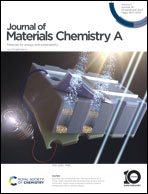Negative-pressure sulfurization of antimony sulfide thin films for generating a record open-circuit voltage of 805 mV in solar cell applications†
Abstract
Antimony sulfide (Sb2S3) has excellent stability and a suitable bandgap for top cell materials in tandem solar cells, attracting intense attention for application in solar cells. However, the complex and unconventional deep-level defects in the quasi-one-dimensional crystal structure of Sb2S3 cause non-radiative recombination, leading to a large open-circuit voltage deficit (VOCD) and posing a significant challenge to improving power conversion efficiency (PCE). This study developed a sulfurization approach at a negative-pressure atmosphere of sulfur (S) for Sb2S3 films. The method could compensate for the S loss in the annealing of Sb2S3 films, transferring them into S-rich states and reducing recombination losses associated with a sulfur vacancy (VS). Simultaneously, the annealing process induced Sb2S3 crystallization with preferential [hk1] orientation, benefiting carrier transport. The reduced deep-level defect and optimized microcrystal orientation enabled a record open-circuit voltage (VOC) of 805 mV in Sb2S3 solar cells. Therefore, this study provided a convenient approach for passivating point defects in metal chalcogenide films and improving VOC in solar cells.



 Please wait while we load your content...
Please wait while we load your content...